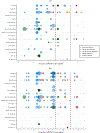Self-regulation mechanisms in health behavior change: a systematic meta-review of meta-analyses, 2006-2017
- PMID: 31662031
- PMCID: PMC7571594
- DOI: 10.1080/17437199.2019.1679654
Self-regulation mechanisms in health behavior change: a systematic meta-review of meta-analyses, 2006-2017
Abstract
Self-regulation is one primary mechanism in interventions for health behavior change and has been examined in numerous recent meta-analyses. This pre-registered meta-review (PROSPERO CRD42017074018) examined Mmeta-analyses of any intervention and health behavior/outcome were eligible if they quantitatively assessed self-regulation and appeared between January 2006 and August 2017. In total, 66 meta-analyses were ultimately eligible; 27% reported a protocol, 11% used GRADE; 58% focused on RCTs. Reviews satisfied only a moderate number of items on the AMSTAR 2 (M = 45.45%, SD = 29.57%). Only 6% of meta-analyses directly examined whether changes in self-regulation predicted the behavior change (i.e., self-efficacy and physical activity, l = 2; frequency of self-monitoring and goal attainment, l = 1; cognitive bias modification and addiction, l = 1). Meta-analyses more routinely assessed self-regulation by comparing the efficacy of intervention components (97%), such as those from behavior change taxonomies. Meta-analyses that focused on intervention components identified several as successful, including personalized feedback, goal setting, and self-monitoring; however, none were consistently successful in that each worked only for some health behaviors and with particular populations. Some components had inconclusive evidence, given that they were only examined in low- quality reviews. Future reviewers should utilize advanced methods to assess mechanisms, and study authors should report hypothesized mechanisms to facilitate synthesis.
Keywords: Behavior change techniques; health; intervention; meta-review; self-regulation.
Conflict of interest statement
Conflict of Interest:
The authors have no conflicts of interest to disclose.
Figures




References
-
- Abraham C, & Graham-Rowe E (2009). Are worksite interventions effective in increasing physical activity? A systematic review and meta-analysis. Health Psychology Review, 3(1), 108–144. doi:10.1080/17437190903151096 - DOI
-
- Albarracín J, Albarracín D, & Durantini M (2008). Effects of HIV-prevention interventions for samples with higher and lower percents of Latinos and Latin Americans: A meta-analysis of change in condom use and knowledge. AIDS and Behavior, 12(4), 521–543. doi:10.1007/s10461-007-9209-8 - DOI - PMC - PubMed
Publication types
MeSH terms
Grants and funding
LinkOut - more resources
Full Text Sources
Medical
